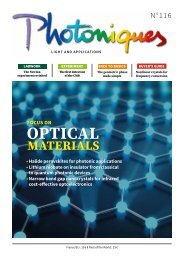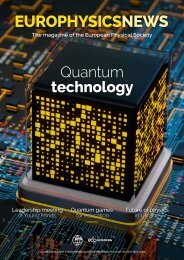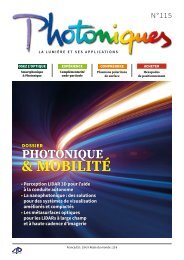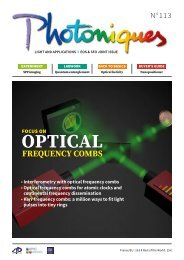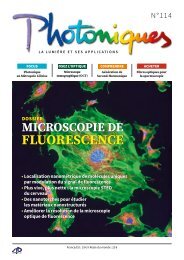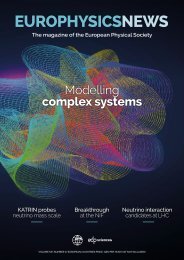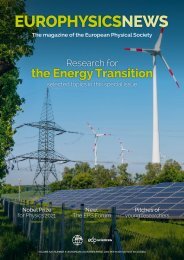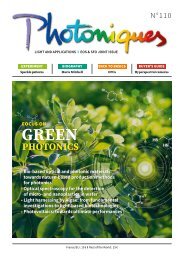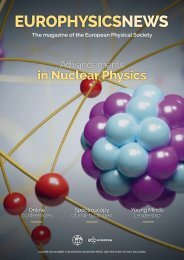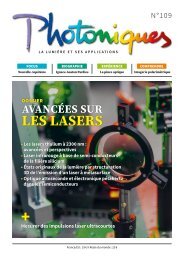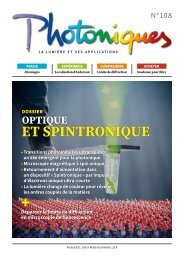EPN 53-3
You also want an ePaper? Increase the reach of your titles
YUMPU automatically turns print PDFs into web optimized ePapers that Google loves.
IN THE SPOTLIGHTS<br />
Highlight from EPL<br />
Modelling the effect<br />
of microwave ablation<br />
Microwave ablation is gaining popularity as an efficient therapeutic option for treating<br />
cancerous tumor cells in patients who are non-surgical candidates. It is a minimally<br />
invasive treatment with a short recovery time. Modelling the effect of the treatment<br />
helps to minimise damage of healty tissues.<br />
Microwave ablation<br />
(MWA) is a material-specific<br />
responsiveness<br />
procedure with the<br />
advantage of faster ablation times,<br />
larger ablation volumes, and potentially<br />
strong deactivations for tumors<br />
compared to other thermal ablation<br />
methods. However, the interaction<br />
of the medical tools with the tissue<br />
may result in healthy tissue damage<br />
which can be eliminated by clarifying<br />
the causation and conditions of their<br />
development. To ensure the destruction<br />
of cancer cells with minimal damage<br />
to healthy tissue, the elevation of<br />
temperature and the evolution of the<br />
necrotic tissue need to be controlled.<br />
Besides experimental methods, computer<br />
modeling is proven to be an effective<br />
approach for improving the<br />
performance of MWA. Moreover,<br />
since the thermal spread in biological<br />
tissue is difficult to measure, generating<br />
the predictive models from procedural<br />
planning to execution may<br />
provide a great impact on patient care.<br />
Due to complexity and computational<br />
resources consumption, most<br />
of the existing numerical models are<br />
two-dimensional axisymmetric to emulate<br />
actual three-dimensional cancers<br />
and surrounding tissue. A mathematical<br />
model for the simulation of MWA<br />
should consist of three essentials components.<br />
The first component includes<br />
the model of the antenna that generates<br />
a microwave field in the tissue.<br />
The second component deals with the<br />
heat distribution in the tissue including<br />
sources and sinks and the phase<br />
changes. The third part describes the<br />
effect of heat on tumor cells and their<br />
destruction. All these components of<br />
the ablation model depend on the dielectric<br />
properties and thermal parameters<br />
of tissues as well as a variety of<br />
material parameters. Additionally, the<br />
inclusion of the temperature dependence<br />
of dielectric properties, the heat<br />
capacity, thermal conductivity, and<br />
blood perfusion, is pivotal for establishing<br />
the correct model of the ablation<br />
process.<br />
Although MWA operates in the frequency<br />
range from 915 MHz to 2.45<br />
GHz, the antenna system at 2.45 GHz<br />
produces greater power deposition and<br />
larger ablations in a shorter time due<br />
to matching the frequency with water<br />
molecule resonance. Microwave power<br />
radiated from the antenna is absorbed<br />
by surrounding tissue, leading to heating<br />
the targeted tissue, consisting of the<br />
m FIG. 1:<br />
a) Temperature<br />
[oC] distribution<br />
and b) fraction of<br />
damage of liver,<br />
lung, kidney, and<br />
bone tissue after<br />
600s of exposure<br />
to microwave<br />
frequency of<br />
2.45 GHz and the<br />
input power of<br />
10 W. The black<br />
circle shows the<br />
boundary of the<br />
tumoral tissue.<br />
tumor and a margin of surrounding<br />
tissue. It was found that temperatures<br />
above 60°C cause relatively instantaneous<br />
cell death, while temperatures from<br />
50 to 60°C will induce coagulation and<br />
cell death in a matter of minutes, typically<br />
10 min.<br />
In our study, calculations were performed<br />
for liver (high perfusion and<br />
large heat sinks), lung (low conductivity<br />
and large heat sinks), kidney (high<br />
perfusion and large heat sinks), and<br />
bone (low conductivity) tissue by using<br />
the Comsol Multiphysics simulation<br />
package. The temperature distribution<br />
has an ellipsoidal shape reaching the<br />
highest values near the antenna slot as<br />
illustrated in Figure 1a. With increasing<br />
the distance from the antenna, the heat<br />
source becomes weaker and the perfusion<br />
of blood limits the extent of the<br />
heated area. The highest and the lowest<br />
values of the temperature correspond<br />
to the kidney and bone tissue, respectively.<br />
Ablation zones are concentrated<br />
around the tip and slot of the antenna<br />
as shown in Figure 1b. The necrotic tissue<br />
is mainly located in the tumor with<br />
a small amount of surrounding tissue<br />
being damaged. Microwaves are less<br />
susceptible to perfusion or heat sinks<br />
so they successfully penetrate deep<br />
into low-conductivity materials such<br />
as lungs and bone. The obtained results<br />
indicate that the simulation technique<br />
can be useful for predicting optimal<br />
conditions for MWA and should be<br />
considered in treatment planning. n<br />
Reference<br />
[1] M. Radmilovi-Radjenovi et al., EPL 136,<br />
28001 (2021)<br />
10 <strong>EPN</strong> <strong>53</strong>/3



